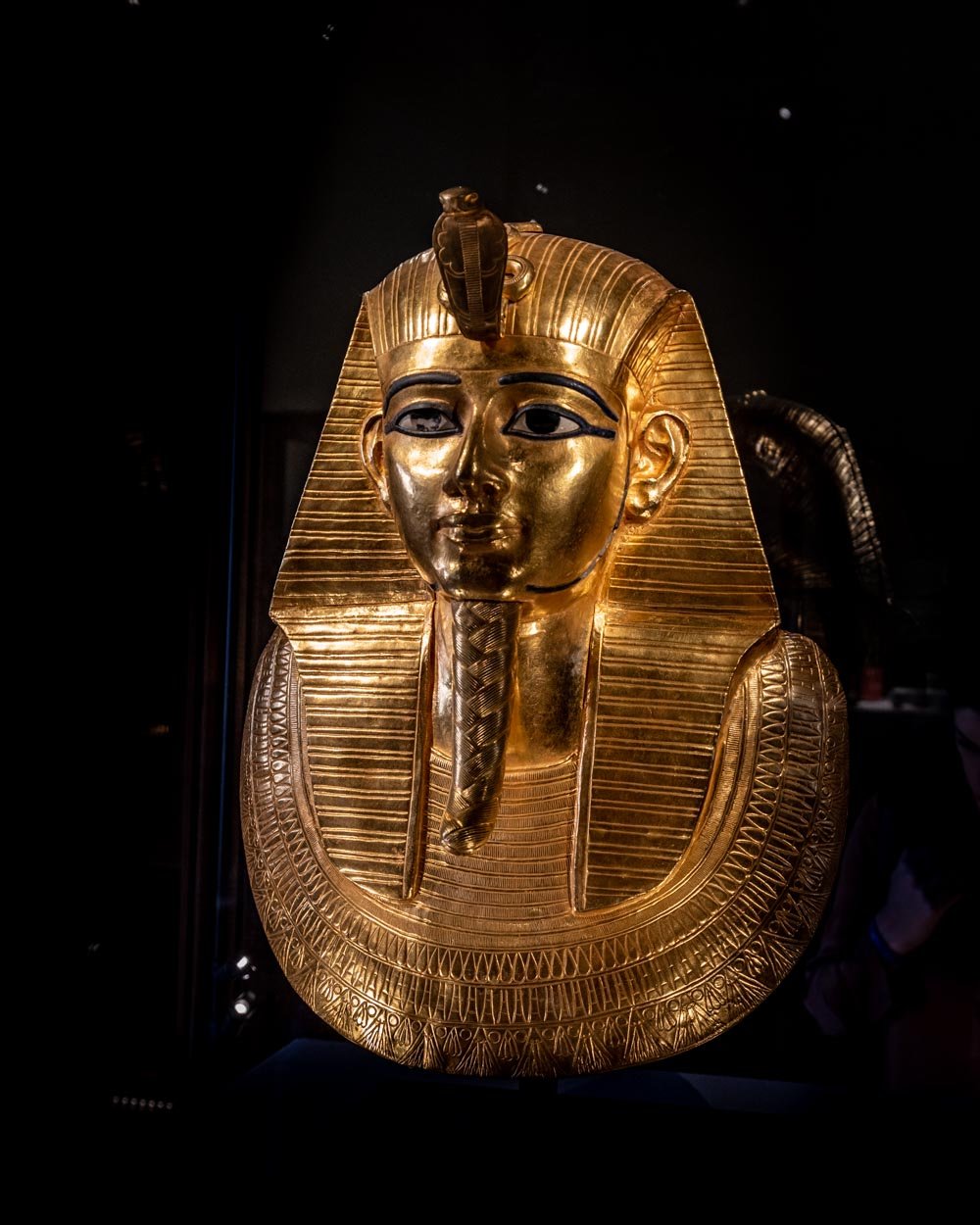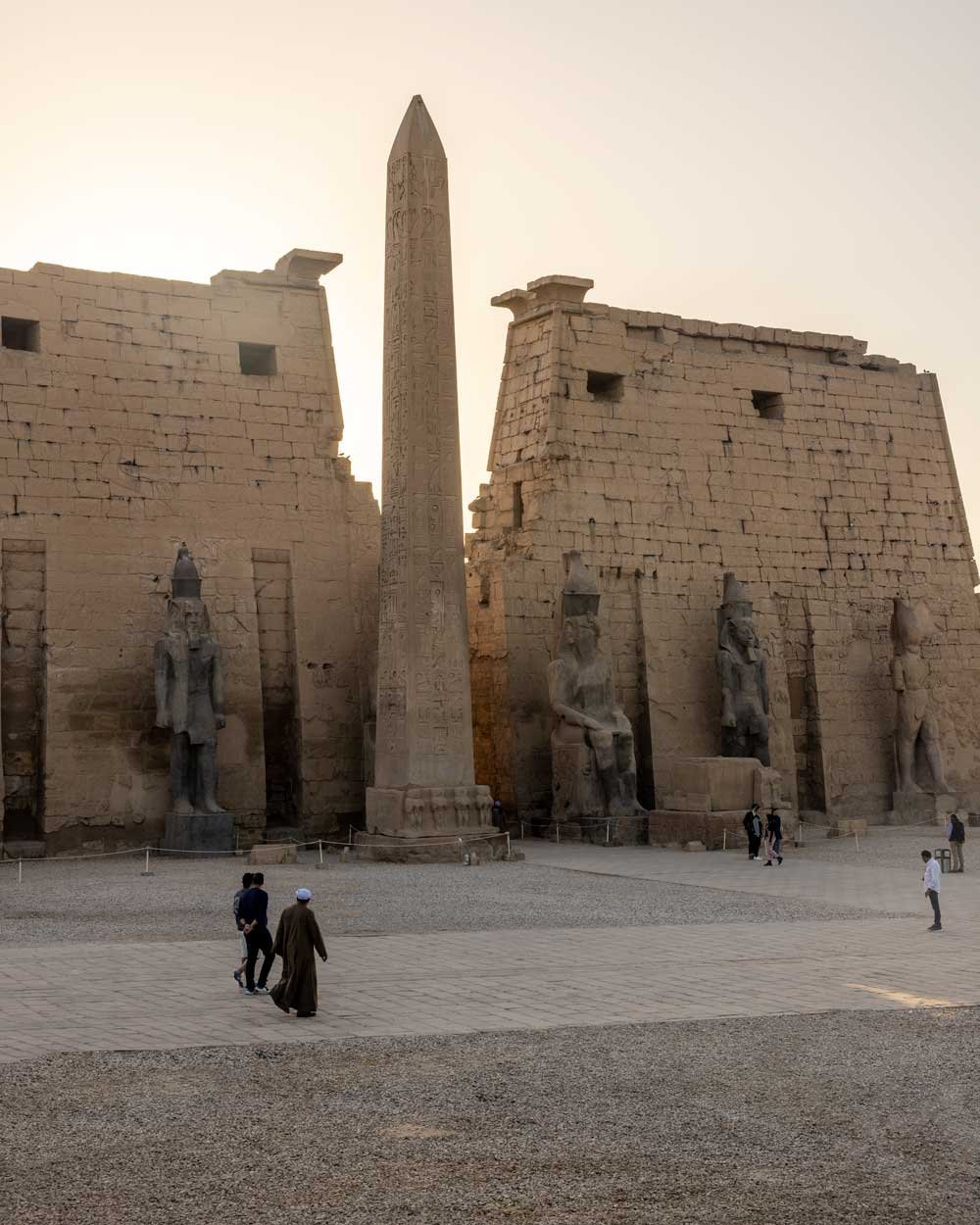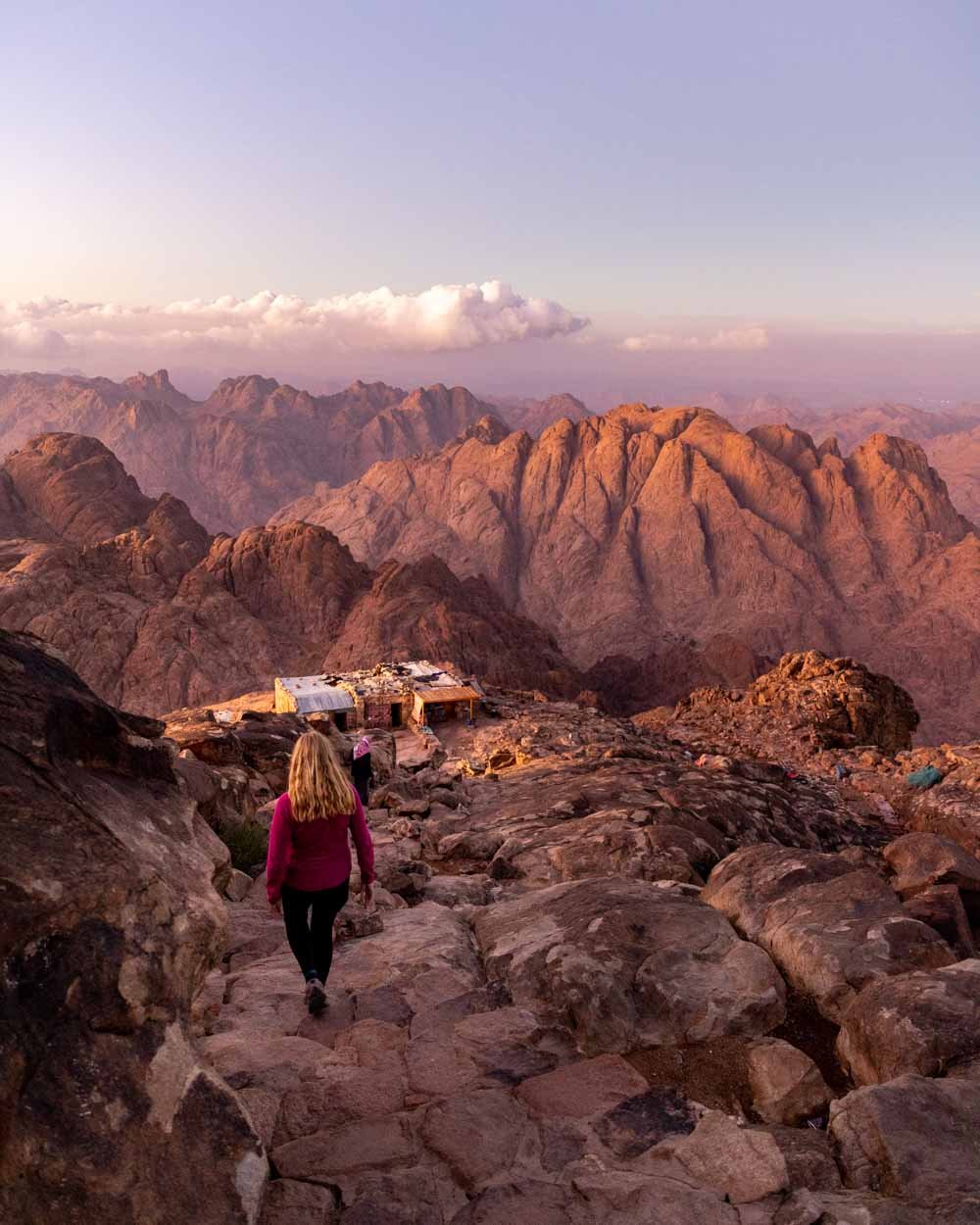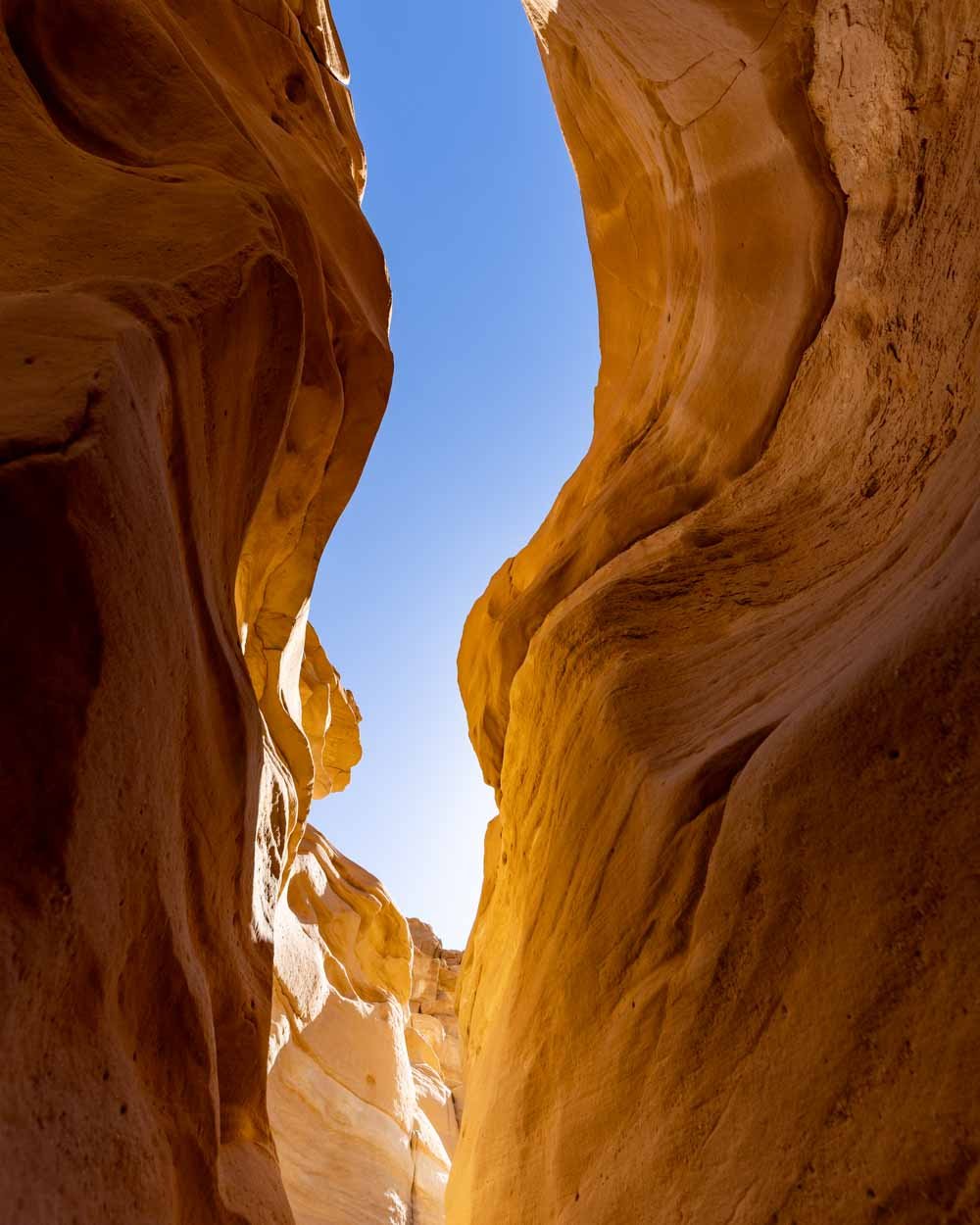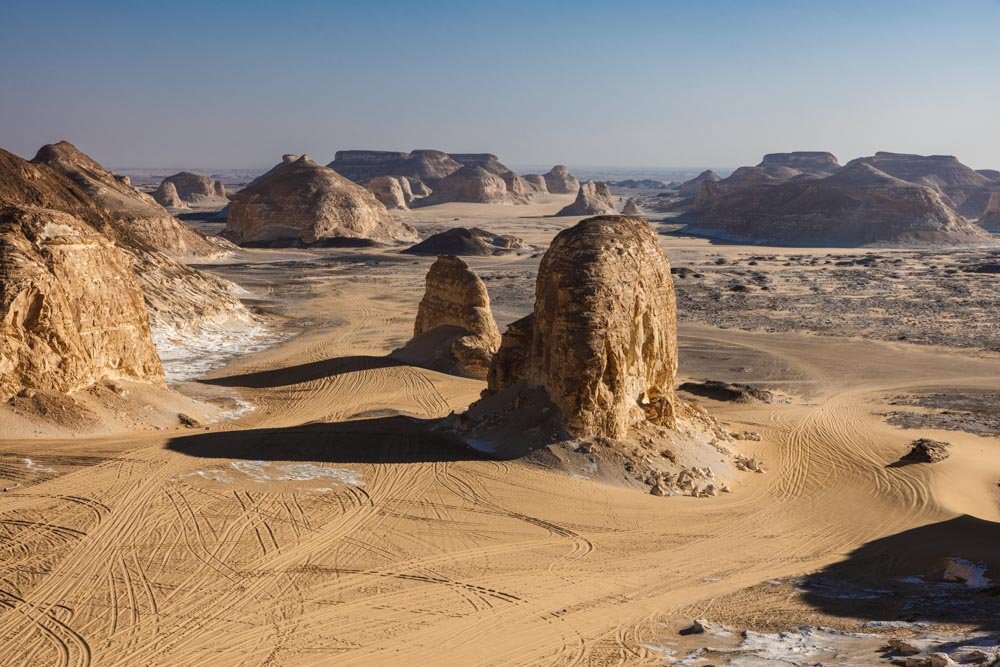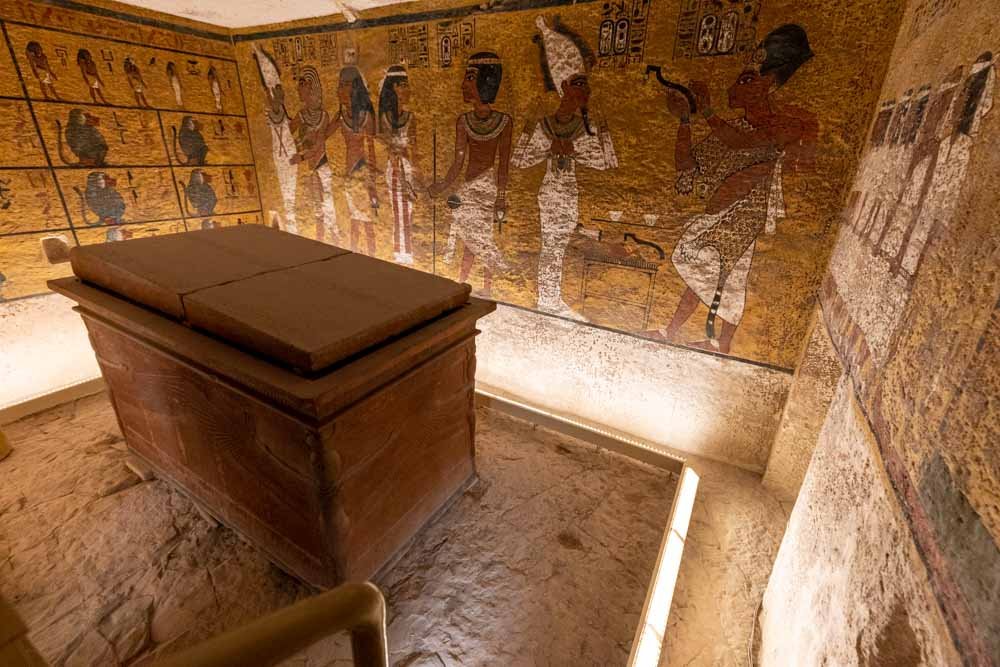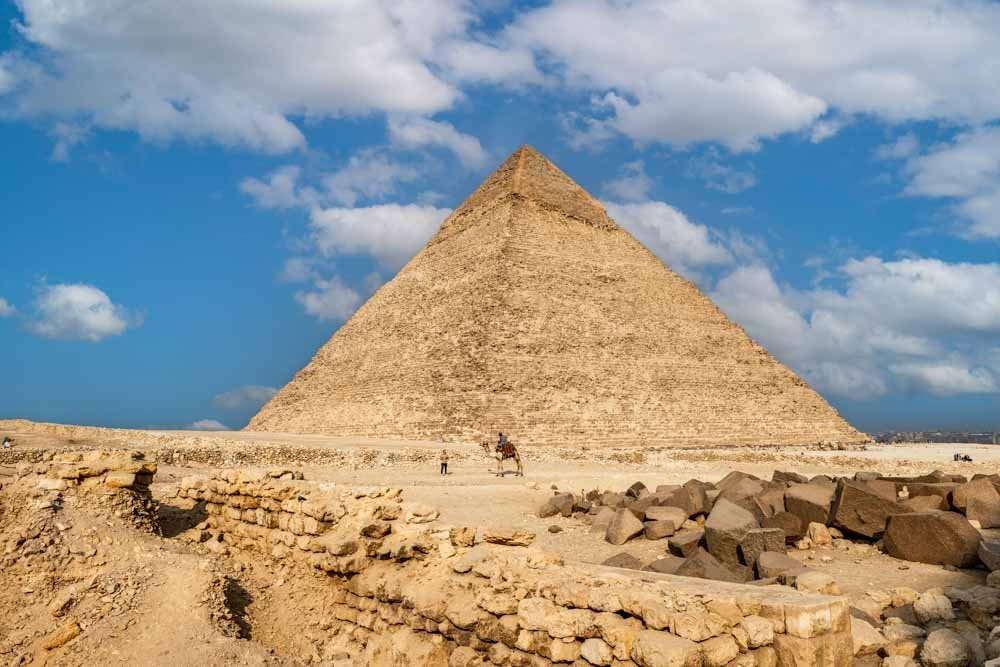If you’ve only got seven days to spend in Egypt, then you are going to have to hit the ground running. Luckily, if you’re happy to pack in the sights, you can see an incredible amount in just a week. From the unmissable historical sites such as the Pyramids, ancient tombs and temples, to the natural wonders, including world class snorkelling, slot canyons and climbing Mount Sinai (Moses Mountain), this itinerary will ensure you have the trip of a lifetime.
We’ve detailed two itineraries below: one that’s suitable for everyone, as the flights go in and out of Cairo, and a slightly more adventurous option, which suits travellers that can fly into other Egyptian airports.
Both itineraries will give you the trip a lifetime.
The two 7 day Egypt Itineraries
The logistics of version one
The itinerary you’ll read first is action packed, covering the best of the historical sights, and assumes you will fly in and out of Cairo (although if you can fly into Cairo and out of Luxor, this saves you a flight).
The logistics of version two
However, if you’re coming from Europe or the Middle East, we have a preferred itinerary which we’ll add below.
The reason we haven’t made our favourite itinerary the primary one, is because you’ll need to fly into Luxor and out of Sharm El Sheikh (otherwise you are flying too much for it to be enjoyable).
We didn’t want to have an itinerary that wouldn’t suit everyone, as we know many flights from the rest of the world will come in and out of Cairo.
If you are lucky enough to be able to fly into Luxor and out of Sharm El Sheikh, then we highly recommend checking out our second itinerary, which is unique, and includes a fantastic mix of history and outdoor adventure.
-
Day 1: Cairo
Day 2: Dahshur & Saqarra
Day 3: Abu Simbel
Day 4: Aswan
Day 5: Luxor
Day 6: Luxor
Day 7: Luxor & Cairo
Itinerary one: Cairo, Luxor & Abu Simbel
Day 1: Cairo - The Pyramids and the Egyptian Museum
AM - The Pyramids
We’re going to kick off the itinerary with the most famous icons in the country. You’ll want to arrive as soon as they open, which at time of writing is 8am. We recommend hiring a driver for half a day, so you can really maximise your time.
With half a day if you keep the pace up, you can visit all three pyramids, go inside one of them, visit the Sphinx, and the major viewpoints. If you’d prefer to go on foot, you’d have to skip the outer viewpoints.
To keep this itinerary from becoming overly long, we won’t go into all the details here, but we’d recommend reading some of our other articles to help you plan the pyramids to perfection, including how to avoid the scams and the best photography spots.
PM - The Egyptian Museum
Until they open the Grand Egyptian Museum, you’d going to have to head into Cairo to visit Egypt’s best museum.
We’d recommend using Uber to get between the Pyramids and the museum, it will save you money, and having to deal with the taxi mafia.
The Egyptian Museum is easily one of my favourites in the world. The fact it’s old, dusty, and for the most part, poorly lit, only adds to the charm for me. You’re viewing artefacts which are thousands of years old, so it all feels very fitting.
The museum has so much to see that no one visit could ever do it justice, but allowing around three hours will give you a great overview. The most famous treasure in the museum is that of Tutankhamun, including his incredible funerary mask and elaborate sarcophagi, as well as countless other riches.
Beyond this you’ll find row upon row of mummies. canopic jars, giant statues and so much more.
Day 2: The incredible lesser visited Pyramids of Dahshur and Saqqara
I know it’s a second day of pyramids in what’s already a tight itinerary, but trust me, these are three pyramids you do not want to miss.
Not only are they in located in a desert setting, rather than on the edge of the city like the ones in Giza, but they are also far less crowded.
The pyramids of Dahshur feel like a proper adventure, and if you delve into their depths it makes for a real Indiana Jones experience.
But even if the thought of crawling into the bowels of the pyramids is wholly unappealing, simply seeing them from the outside is magical.
After visiting the Red and Bent Pyramid at Dahshur, you can head to the step pyramid of Saqqara, the oldest pyramid in the world. If you are making good time, on the way you can stop at Memphis City, with its open air museum. We heard good things, but didn’t have time to stop as a burst tyre meant we’d started our day much later than planned.
Once you arrive at Saqqara it’s worth walking right the way around the base of the pyramid. On the far side of the northern face of the pyramid, you’ll find two holes cut into a block, and when you look in, you’ll see a statue of Djoser, the pharaoh buried inside the pyramid.
It’s believed that this was created so Djoser could watch the north star pass, aiding his passage into the underworld.
As well as the pyramid, there are many tombs you can visit, to be honest you can spend the whole day at Saqqara alone, but even with just a few hours you can get a great overview.
Although you can take a tour which covers Dahshur, Memphis and Saqqara, we’d recommend simply hiring a taxi for the day and having complete control over your itinerary.
All the details on pricing and what to expect at each site, including what it’s like going inside the pyramids are in this guide.
Where to stay in Giza
For the purposes of this itinerary it’s better to stay in Giza than Cairo. The only activity in Cairo is the Egyptian Museum, and it won’t be long before the Grand Egyptian Museum in Giza will open and then all activities will either be in Giza itself, or closer to Giza than Cairo.
Guardian Guesthouse - budget option
Few hotels in the world have a view that can rival Guardian Guesthouse. Situated just metres from the entrance to the pyramid complex, the best rooms here have head on Sphinx views, with the pyramids behind it.
Sunset from the room is simply magical and you can even get a free glimpse of the sound and light show in the evening from the hotel rooftop.
The view from our room at the Guardian Guesthouse
It’s also one of the few places in Giza that is almost entirely away from the car horns and engine noise of Giza, as it’s tucked away beside the Sphinx, which is completely dead when it’s closed. The rooms are dated, but clean and comfy enough.
Check the latest prices & reviews on:
Marriott Mena House - luxury option
The Marriott Mena is what pyramid dreams are made of. This historic hotel is situated within walking distance of the entrance to the Pyramids and has hosted some of the most famous people in the world, including US Presidents, movie stars, writers and musicians.
The view from the grounds are spectacular, with Khufu’s and Khafre’s pyramids overlooking the green oasis of Mena House.
If you’ve got the budget, this is the place to stay in Giza.
Day 3: Abu Simbel
Abu Simbel is not the easiest place to get to, but it’s worth it. We think you’ll get much more from the experience by staying overnight, and that’s what made it really special for us.
Not only will you be able to view these incredible temples in the afternoon when all the day trippers have gone home, but you’ll also be able to see the temples by night.
Strolling up the wooden walkway, under the gaze of the four gigantic Rameses carvings is a dramatic start.
Inside the temple there are four imposing statues on each side of the chamber which really loom over you, creating such a mysterious atmosphere. Walking inbetween them is an incredibly memorable experience.
We’d recommend heading to the temples 2-3 hours before closing to give yourself plenty of time to explore.
After this grab dinner at Elmodesh, it’s all local food and one of the best meals we had in Egypt. The fish comes straight from the local lake and on to the BBQ.
Then head back to the complex for the sound and light show. Yes it’s very dated, but we actually did learn quite a lot from the voiceover (we’re pretty sure it was James Earl Jones aka Darth Vader) and it was amazing to be in the temple complex at night.
After the show has finished you can wander the outside of the low lit temples for a while, which was a very special experience.
You can read more in our detailed guide to visiting Abu Simbel.
Getting from Cairo to Abu Simbel
The easiest way to get from Cairo to Abu Simbel is by plane. Unfortunately at time of writing, there are no direct flights, so you have to go via Aswan. However, one flight a day does connect with a minimal wait time, so it is both possible and popular to fly this route.
We had more time so we flew to Aswan and took a private car from there, but on a 7 day itinerary that just wouldn’t be feasible.
Where to stay in Abu Simbel
There are a number of hotels in the village and we chose to stay at a midrange option. Hotels in Abu Simbel are in my opinion very overpriced, but worth it for the chance to see the temples without the crowds, and by night. We stayed at the Hllol Hotel, the room is very basic, but pretty quiet after 9pm and decent enough for a night.
We also debated the Eskaleh Nubian Ecolodge which was slightly more expensive, but probably worth the extra money.
Day 4 - Abu Simbel to Aswan, and exploring Aswan
AM - Abu Simbel to Aswan
You can choose whether to fly to Aswan (less than 45 minutes) or take a car which takes around 3.5 hours. There’s nothing to see on route, so there’s no advantage to driving in that regard, but I don’t like flying, so that’s the option we took. The road is paved all the way and in excellent condition, so it’s an easy if unremarkable route.
If you were super keen and full of energy, before you leave, you could start your morning with a cruise on the lake, which allows you to see the sun rise over the temples. We debated this and in hindsight I wish we’d done it, but at this point we’d done so many sunrises we couldn’t face another early start! If you do want to do the trip I know that the Eskaleh Nubian Ecolodge can organise it.
PM - Exploring Aswan
There are so many sites to see in Aswan and with just an afternoon it’s better to pick just one.
Many people opt for the stunning Philae Temple. However - as you will be seeing a vast number of temples in Luxor - we’d recommend heading down the Nile to the Nubian village for something a little different.
You can also take a boat over to the botanic garden, which would also be a lovely way to spend the afternoon.
If you decide to head to the village, you’ll take a motorboat along the Nile, the journey takes about 35 minutes and is very scenic.
Once you arrive at the village you can potter around the market (super touristy, but it had nicer things than we’d seen in other places) or do as we did and take a wander around the back streets before cafe hopping along the Nile.
The whole village is painted with vibrant colours and the views over the Nile from all the cafes were fabulous. We spent several hours relaxing beside the water with delicious hibiscus tea.
You can read more details on how to organise your own trip to the Nubian village (you don’t need a tour) in this guide.
Where to stay in Aswan
The Movenpick
We didn’t rate the hotel we stayed at in Aswan, as it was so noisy. Instead we’d recommend the Mövenpick Resort Aswan, which gets great reviews and looks lovely from the pictures. We saw it across the water from our hotel and kept wishing we were there!
Check the latest prices & reviews on:
Day 5: Getting to Luxor, a sunset sail on the Nile and museums by night
AM - Getting from Aswan to Luxor
At time of writing you can’t fly from Aswan to Luxor directly, so you’ll want to take a taxi or get the train. We took a taxi. If you want to go directly, make sure you ask them to take the highway route.
There’s a longer route with some pretty bad roads and it’s terribly slow - you do not want to go this way, trust us.
That is, unless you want to see some temples on route - Esna, Edfu, and Kom Ombo. The downside to this is that it would take precious time away from Luxor.
PM - Sunset sail on the Nile and museum
If you’re looking for the most relaxing way to end a day in Luxor, this is it. Sailing along the Nile, bathed in golden light, is a quintessential Egyptian experience.
The traditional feluccas are the way to go, and it’s wonderful to drift along the water without the typical engine noise.
You want to begin your felucca ride about two hours or so before sunset. This gives you enough time to have a leisurely cruise and to stop to pick up some fruit from Banana Island for a late afternoon snack.
We recommend organising this yourself at the boat dock, as you’ll get a private sail and it’s more cost effective than a tour. You can find out how to go about organising your boat trip here.
After sunset, grab a quick dinner and then head to the fantastic Luxor Museum. It’s open until 9pm and a night time visit is more fun and atmospheric in my opinion.
If you still have the time and energy afterwards, head to the nearby Mummification Museum - this one is very small, so you only need around 20 minutes.
It’s not a must do as you will see several mummies in the Luxor Museum, but it does offer more detail on the mummification process and you’ll see a few mummified animals too!
Day 6: The Valley of the Kings and the West Bank
Seeing the best of the West Bank in one day is full on, but possible. Start at the Valley of the Kings as early as you can manage (it opens at 6am).
The tombs are magnificent with exquisite paintings that you cannot believe are over 3000 years old. Some are also incredibly atmospheric and have that mysterious feel that you dream about when planning your trip to Egypt.
However, not all tombs are created equal. We visited every single one to bring you the full low down on each, which you can read here.
In short though, if you don’t want to purchase additional tickets beyond the general entry, then head to the tombs of Rameses III, Rameses IV and Tausert/Setnakht (you only get 3 of the 12 tombs included in the general entry).
If you want to visit the best of the best then you can’t miss the awe-inspiring tomb of Seti I.
The next stop would be the Valley of the Queens, however, if you’re not planning on visiting the very expensive, but magnificent tomb of Queen Nefertari, then it might not be worth it.
Apart from Nefertari's tomb, which is one of the best in all of Egypt, the tombs pale in comparison to those in the Valley of the Kings.
We’d probably instead recommend heading to the Valley of the Nobles and visiting a couple of lesser known tombs. They have some great artwork and none of the crowds you’ll find at the Valley of the Kings.
After either the Valley of the Queens or Nobles, head to the Ramesseum. Anywhere else in the world this would be a huge tourist attraction, however, this was the quietest place we visited in the whole of Luxor and that’s probably because it’s not in as good condition as many of the other sites - but still fabulous by world standards.
End your day with the Temple of Hatshepsut which is probably the most visually stunning of any temple in Luxor on the approach.
It’s not so ornate up close and has been heavily reconstructed after being largely destroyed by earthquakes in the 9th century BC. However, the setting is so good you can’t miss it. It’s also particularly attractive in the late afternoon light.
As you leave the West Bank, if you have time, stop at the Colossi of Memnon for a quick photo before moving on to Luxor City.
Day 7: Luxor City and travel back to Cairo
Unfortunately it’s another early start because if you want to see the jaw dropping Karnak Temple at its best, you should go for sunrise.
I’ve visited Karnak Temple three times now and it never loses its magic. Although the site is huge, it’s the 134 giant columns in the Great Hypostyle Hall that will forever be etched in your memory.
Walking amongst them makes you feel small in the best possible way. Some still have detailed artwork in quite good condition, although most is largely worn away. Allow a couple of hours to see the best of it.
After Karnak, it’s time to head to Luxor Temple. It’s yet another example of the pharaohs’ incredible architectural feats. Whilst it’s not quite as impressive as Karnak, it is still a remarkable temple that has several ages in history depicted on its walls - including sections commissioned by Alexander the Great!
You can also take a look at the start of the Avenue of Sphinxes, located right by the temple entrance. The first 130m of the 3km long walkway have the most intact statues.
After this it’s time to toast your trip at the Winter Palace Hotel. It’s so close to Luxor Temple you can even walk! The Royal Bar is the place to head for a glass of wine in a traditional colonial lounge, think arm chairs and low lighting.
Alternatively the Victorian lounge is the place to head for a cup of tea in a large opulent room. There actually isn’t much seating here, just a few large sofas, but they are rarely in use from our experience.
Don’t forget to take a walk around the gorgeous garden before leaving, we loved watching all the little Hoopoes flitting around the grounds.
After this, it’s time to either catch your flight to Cairo, or hop on the night train if you have slightly more time.
We picked out our favourite things to do in Luxor for this itinerary, but you can look for more ideas in our Luxor guide to make sure we haven’t missed anything you’d prefer.
Where to stay in Luxor
Hilton Luxor Resort & Spa - Luxury option
We stayed in the Hilton in Luxor and it was one of the best hotels we stayed at in Egypt. Firstly, it is a bit of a quiet oasis, you can step into your room and escape the road noise and bustle of the streets of Luxor.
The beds were incredibly comfortable, the rooms were spacious and the showers were perfect for washing off the dust from a day visiting the West Bank.
Steigenberger Resort Achti- Midrange option
We also stayed in the Steigenberger Resort Achti, which was very good value. The rooms were generally quiet (a few roosters and a little street noise in the evening, but not the night time) and the bed was very comfortable.
The location is good and for the price the place was a steal (for reference we paid less than USD $40). However, the bathroom could have been better, the shower had weak pressure and it was a bit small and dingy.
Getting between Luxor and Cairo
The two best ways to get between Luxor and Cairo are either on the overnight train (10.5 hours), or by plane (1 hour). You can also take a day train, but that would wipe out an entire day, which wouldn’t be a good use of time on a tight itinerary.
We took the night train between Cairo and Luxor, which was a bit of an adventure, but not that conducive to a good night’s sleep (it is one seriously jolty ride!) - and that’s despite the fact we had beds!
Taking the train is usually more expensive than flying if you book your flights in advance, but it does mean you don’t have to pay for a hotel that night, so overall it usually works out cheaper.
The one thing to consider before booking the train is that you likely won’t get much sleep. Depending on what you have planned for the next day, that might not be ideal. You can read our guide on the sleeper train experience to help you make the decision.
Itinerary two: Luxor, Cairo & the Red Sea
As we mentioned above, this itinerary includes the Red Sea/Sinai - one of our favourite places in Egypt.
It requires being able to fly into Luxor and out of Sharm El Sheikh, but if this is possible, then you’ll experience some incredible canyons and snorkelling, as well as all the bucket list historical sites.
Day 1 - 2: Luxor and the West Bank
In this version, you’ll fly directly into Luxor. We would recommend doing Karnak Temple and a felucca ride on the first day and then a full day on the West Bank on day two (the same as the itinerary above).
At the end of day two, either take an evening flight, or night train to Cairo.
Day 3 - 4: Cairo
Days three and four will be exactly the same as in the itinerary above. Starting with a day at the Pyramids and the Egyptian Museum, followed by a full day at the outer pyramids of Dahshur and Saqqara.
This link will take you to day three and this one to day four. On the evening of day four fly from Cairo to Sharm El Sheikh, before transferring to Dahab by taxi.
Day 5: Dahab - Saint Catherine’s Monastery and Mount Sinai (Moses Mountain)
Now you’re in the Red Sea, it’s time to take in the famous Mount Sinai & Saint Catherine’s Monastery, which is about 1.5 hours from Dahab.
We’ll explain how to include this in your itinerary below, but you can also read all the details, including cost and logistics, as well as full trail notes in this guide to climbing Mount Sinai. Our suggestion is to do the opposite to every other tour - go to Saint Catherine’s Monastery in the morning and hike up Mount Sinai for sunset, as this is the best way to avoid the crowds.
AM - Saint Catherine’s Monastery
It’s hard to imagine a monastery in a more spectacular location than Saint Catherine’s Monastery. Backed by the jagged peaks of the Sinai Mountains, the setting is out of this world.
The monastery itself is also incredibly picturesque and dates all the way back to 330 AD. The highlight is the basilica with it’s collection of ornate lanterns. You can’t take pictures inside this room, but it will likely remain forever etched in your mind.
You can also visit the burning bush, where God spoke directly to Moses.
PM - Climb Mount Sinai (Moses Mountain) for sunset
The view from the top of Mount Sinai (aka Moses Mountain) is jaw-dropping. Endless jagged mountains and vast desert as far as the eye can see. When you’re at the top for sunset, then it becomes even more magical.
The 12km return walk is steep in places, but the trail is in excellent condition and there are drink stops galore.
If you head up for sunset you will get to experience the walk and summit views with very few others, as it’s typically climbed for sunrise.
On the way back down you can stop to do some star gazing, we were lucky enough to see the full Milky Way.
You can visit the monastery and mountain on a group tour, but personally we wanted to go alone, so we organised a private car.
Day 6: Dahab - Incredible slot canyons
Day six is all about the stunning slot canyons of the Sinai Desert - the type you would expect to see in Utah and Arizona rather than Egypt!
We visited five canyons in the area, and it’s really hard to choose which of the two big ones you should do.
We’ve opted for Coloured Canyon, as it’s utterly spectacular and a fairly easy walk. If you’re into adventurous canyoning, think sliding down sections, rather than walking, then we highly recommend you check out our guide on Arada Canyon.
Arada Canyon
Arada Canyon
Coloured Canyon
Anyway back to Coloured Canyon. This is one of the most beautiful canyons we’ve ever visited and a highlight of our month in Egypt. Walking under its towering red walls is an unforgettable experience.
You’ll start in open canyon before making your way through two narrow slots, one of which was a staggering 400m long and utterly jaw dropping.
It’s generally an easy walk, but there are a couple of slightly trickier bits which your guide can help you with if needed. And on that note you need a guide for all Sinai canyons.
Make sure you read our article on Coloured Canyon, as there is currently a scam operating in which you’re taken to a smaller and far less spectacular canyon. You’ll also find all the details on the guide we used who was great.
White Canyon & Salama Canyon
As Coloured Canyon can only be visited on a private tour, you can add in several more stops to create a full day trip.
We chose White Canyon and Salama Canyon, as well as Mushroom Rock and a desert oasis for lunch.
However, if you’re not as fanatical about canyons as us, you can look through this guide on things to do in Dahab for more ideas to make up your ideal day.
White Canyon
Day 7: Dahab - Snorkelling in the Red Sea
It’s been a pretty hectic pace up to now, so on your last day you can either keep that up, or go leisurely. Dahab’s Blue Hole is world famous for both diving and snorkelling, and it’s in our top three snorkel spots of all time.
The colourful fish and steep coral shelves are mesmerising and it’s very easy snorkelling - you can just walk off the shore and within minutes you’re in deep water. No boat trip or tour guide required.
All the details on how to get there and where to rent gear etc are in this guide.
This is a worthy last day in its own right, but if you’re still raring to go then you could also visit the Blue Lagoon, which is reached via the Blue Hole.
That’s either via a 5.1km easy coastal walk (which is stunning), or by a 10-15 minute boat ride. After either option you then need to take a 10 minute pick up truck ride to the lagoon itself.
From here you’ll be at what’s commonly referred to as the Maldives of Egypt. It’s a turquoise lagoon, which is sheltered from the open sea and perfect for swimming (we went close to sunset, so you can expect the water to be much more spectacular in the middle of the day).
Where to stay in Dahab
Many visitors to the Red Sea head for the glitzy resort town of Sharm El Sheikh. However, we much preferred the more low key vibe of Dahab.
It’s also closer to all the activities we’ve listed, and the tours that run from here are cheaper than in Sharm El Sheikh.
Le Meridien - Midrange
Le Meridien is an oasis of tranquility in Dahab, it was perfectly quiet - which is incredibly rare in Egypt. As it’s set a little way out of town, it means you’re away from the hustle and bustle, but the drive in only takes 10 minutes.
The deluxe rooms are comfy, quiet, spacious and some come with an outdoor shower, which was my absolute favourite way to end the day.
The resort also has 3 pools (2 saltwater, 1 fresh), its own beach and pretty grounds. It’s one of the best hotels we stayed in in Egypt and if you visit out of peak season, you can snag a great deal.
Check the latest prices & reviews on:
Essential information before visiting Egypt
Is Egypt safe?
Before you travel, we recommend checking your government’s advice on the security situation in Egypt, as it can change. Personally we felt very safe, with the biggest problem being overly pressurising souvenir sellers and taxi drivers!
At first, the sight of police checkpoints is jarring, but it soon becomes a reassurance that Egypt takes its security very seriously and they work hard to protect travellers coming into the country.
Visas
Unless you plan on only staying in Sharm El Sheikh, all travellers to Egypt will need to buy a visa. You can buy one on arrival, but you can avoid the long queues by buying one online before you arrive.
Best time to visit Egypt
Egypt is an incredibly hot country, so we recommend visiting during the winter months (November - February) for the cooler day time temperatures. The compromise is that you’ll have less daylight hours. However, we felt that 10 hours of daylight in December was plenty to make the most of each day.
Shoulder season is still a decent time to visit, but the daytime temperatures will be in the 30’s (celsius), so you will want to plan to avoid the worst of the heat. The summers in Egypt are incredibly hot and not ideal for exploring. We have visited in summer and it’s best to utilise early mornings and late afternoons and rest through the hottest part of the day.
Getting around Egypt
By road
The roads in Egypt are generally excellent, but the drivers are pretty crazy, and whilst we have driven in a lot of countries around the world, we chose not to in Egypt.
The best way to get around the major cities is by Uber when you can, or taxi, or find a driver (you’ll often be approached by them in the major tourist areas in each town). This can involve a tiresome amount of negotiating, but it’s by far the easiest way to get around. Thankfully, in Cairo and Alexandria you can use Uber, which is a godsend as Cairo is the worst for scammy taxi drivers.
Domestic flights
At the time of writing (January 2023), virtually all domestic flights go to or from Cairo, meaning there are no flights from Luxor to Sharm El Sheikh, Alexandria to Aswan etc. The only domestic flight we saw that didn’t involve Cairo was Aswan to Abu Simbel. This may change in the future, so always check.
We flew with Egyptair, Air Cairo and Nile Air, all of which were pretty decent and there wasn’t much to choose between them. It pays to check the safety record of the airline you plan to fly with in Egypt as there are some you may want to avoid.
Hotels in Egypt
Hotels in Egypt aren’t quite to the standard you’d expect of a destination which is on most people’s bucket list. We often found that even many international 5* hotel brands were overpriced and under-delivered, so prepare to adjust your expectations.
The biggest problem with all but a few hotels in Egypt is noise. A huge proportion of the population seem to work during the night and they use their car horns aggressively. In cities like Cairo it can be so loud that no amount of soundproofing can fight the blend of car horns, engine revs and people shouting. If you are a light sleeper, then you may want to bring ear plugs or some other noise cancelling solution to help.
Money
Egypt is an almost entirely cash based society. Outside of hotels and flights, we found that almost no one took card payments - even some tourist restaurants only accepted cash. Having a bank card with low international ATM withdrawal charges will save you a lot of money.
The local currency is the Egyptian pound, and whilst some places will take US dollars, it’s far easier to prepare to withdraw Egyptian pounds several times during your trip.
WiFi & local sim cards
The WiFi speeds in Egypt are woeful, so we recommend coming prepared with an alternative way to access the internet. We chose to buy local sim cards at the airport to ensure we could use Uber, plan on the go, and never have to rely on a hotel or cafe’s wifi.
Network coverage is very good in Egypt - sometimes it even worked in really remote places such as the Western Desert or the Sinai - and internet speeds are also pretty decent. We bought a sim with Vodafone and Etisalat, and there wasn’t much to choose between them, so go for the best deal. We paid about $30 USD for 100GB of data, which is a bit of a bargain.
This post may contain affiliate links, meaning at no additional cost to you, that we will earn a small commission if you click through and decide to make a purchase. This helps towards the costs of running our website. Thanks for your support.







